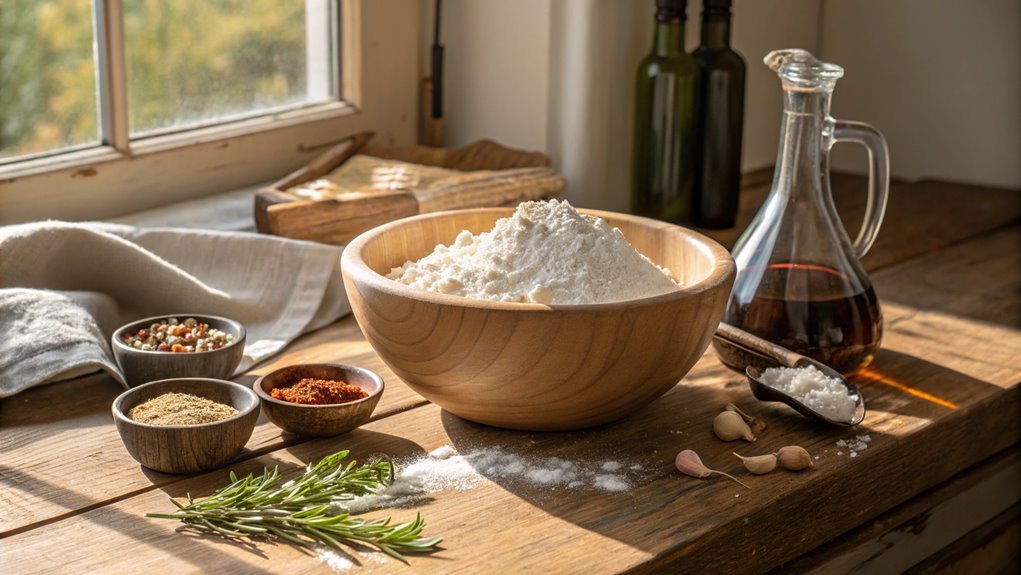How To Make Seitan From Scratch

Creating seitan from scratch is a fulfilling way to make a tasty meat substitute at home. Using essential wheat gluten and vegetable broth, you can form an elastic, flavorful dough. The cooking method significantly influences its texture and taste, so experimenting is enjoyable. Ready to explore the secrets of each technique?
Recipe
Making seitan at home is an enjoyable and fulfilling experience. With just a few simple ingredients, you can create a delicious meat alternative that’s rich in flavor! Begin by mixing the essential wheat gluten with flour and spices of your choice. Gradually incorporate vegetable broth or water to form a stretchy dough. Seitan is known for its versatility in various dishes, allowing you to experiment with different cuisines and flavor profiles.
For a variety of flavor profiles, consider adding ingredients like soy sauce or nutritional yeast. Seitan can be prepared using various cooking methods such as steaming, boiling in broth, or baking. After cooking, pan-fry the seitan for a crispy texture. Experiment with different sauces to create unique and satisfying meals every time!
Ingredients:
- Essential wheat gluten
- All-purpose flour
- Vegetable broth or water
- Soy sauce (optional)
- Nutritional yeast (optional)
- Your favorite spices
Instructions:
1. Prepare the Dry Mix: In a large mixing bowl, combine 1 cup of essential wheat gluten with 1/4 cup of all-purpose flour. Add any spices you like, such as garlic powder, onion powder, paprika, or black pepper.
2. Create the Dough: Slowly pour in 3/4 cup of vegetable broth or water while stirring the mixture. If you want additional flavor, add 1-2 tablespoons of soy sauce or nutritional yeast. Mix until a stretchy dough forms.
3. Knead the Dough: Transfer the dough to a clean surface and knead it for about 5-10 minutes until it becomes elastic. This step is crucial for the texture of your seitan.
4. Shape the Seitan: Divide the dough into pieces, shaping them as desired, whether into patties, cutlets, or strips.
5. Cook the Seitan:
- Steaming Method: Wrap the pieces in foil and steam for about 30 minutes.
- Boiling Method: Immerse the pieces in a simmering broth and cook for 45-60 minutes.
- Baking Method: Place the pieces on a baking sheet and bake at 350°F (175°C) for 30 minutes, flipping halfway through.
6. Pan-Fry for Crispiness: Once cooked, heat a little oil in a pan over medium-high heat. Add the seitan pieces and fry until they’re golden brown and crispy on the outside.
Extra Tips:
When making seitan, remember that the kneading process is key to achieving the right texture. The more you knead, the firmer and meatier your seitan will be. If you prefer a softer texture, reduce the kneading time.
Additionally, experimenting with different spices and liquid flavorings can significantly alter the taste, so don’t hesitate to try new combinations. Lastly, if you’re boiling your seitan, ensure the broth is flavorful, as this will infuse the seitan with extra taste. Enjoy your homemade seitan in a variety of dishes!
Frequently Asked Questions
Can Seitan Be Made Gluten-Free?
Absolutely, you can explore making gluten-free seitan!
While traditional seitan relies on gluten for that perfect chewy texture, you can use gluten alternatives like teff flour, buckwheat flour, or sweet rice flour.
Mixing these with binding agents, such as nutritional yeast and tapioca flour, creates delicious textures.
Though it mightn’t fully replace classic seitan, experimenting with these substitutes can yield tasty results.
Immerse yourself and discover your own gluten-free delights!
How Long Does Seitan Last in the Refrigerator?
Once you’ve opened seitan, proper seitan storage is key to maintaining its deliciousness!
Store it in the fridge and aim to eat it within 3-5 days. If you want to keep it longer, homemade seitan stays fresh for about 5-7 days in its cooking broth.
Make sure to check for signs of spoilage like odd smells or discoloration.
Enjoy your flavorful creations while they’re at their best—happy cooking!
Is Seitan Safe for People With Wheat Allergies?
Seitan might seem like a delicious option for many, but it’s not for everyone.
If you have wheat allergies, you’ll want to steer clear of it. Those seitan ingredients, primarily wheat gluten, could trigger severe reactions, from stomach issues to anaphylaxis.
It’s crucial to read labels carefully and explore other tasty plant-based proteins like tofu or lentils.
Cooking can be exciting when you choose ingredients that suit your dietary needs!
What Is the Nutritional Content of Seitan?
Seitan packs a fantastic protein profile, boasting between 17 to 21 grams per serving, making it a great meat alternative!
With a calorie count of just 90-104 for a 2.5-3 oz serving, it’s low in fat and carbs, too.
Plus, it’s rich in iron. If you’re looking to switch up your meals or boost your protein intake, seitan’s deliciously versatile.
You’ll love experimenting with it in various recipes!
Can Seitan Be Frozen for Later Use?
Yes, seitan can be frozen, making it perfect for long-term storage!
Just cool it to room temperature, drain excess liquid, and slice it into meal-sized portions.
Wrap each tightly in cling film or foil to fend off freezer burn, then pop them into zip-up bags.
Don’t forget to label yours with the date!
When you’re ready, thaw it overnight in the fridge, and enjoy its delightful texture in your favorite dishes!
Conclusion
Now that you know how to make seitan from scratch, unleash your culinary creativity! Fry those golden-brown pieces in your skillet and transform simple dough into a mouthwatering masterpiece.
Enjoy the endless possibilities of this versatile meat alternative in hearty stir-fries, comforting stews, or your favorite sandwiches. So roll up your sleeves, grab your ingredients, and dive into this delicious adventure.
Happy cooking! Your taste buds are in for a treat!





